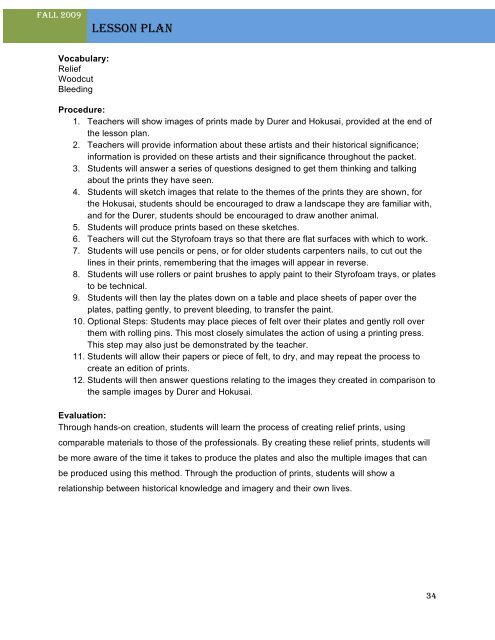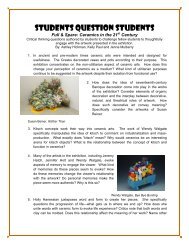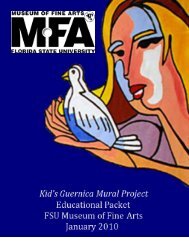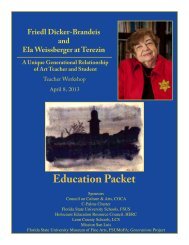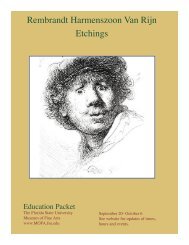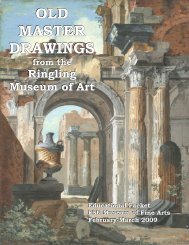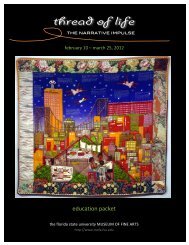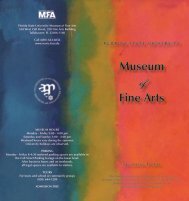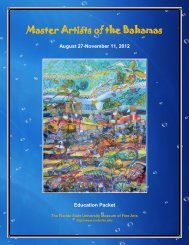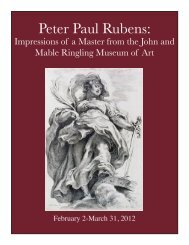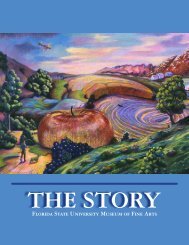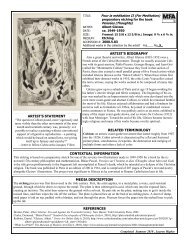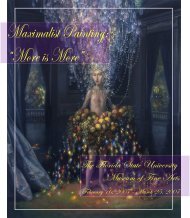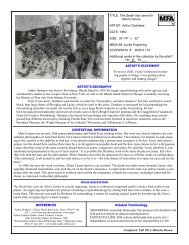Matrix: Contemporary Printmaking - Museum of Fine Arts - Florida ...
Matrix: Contemporary Printmaking - Museum of Fine Arts - Florida ...
Matrix: Contemporary Printmaking - Museum of Fine Arts - Florida ...
Create successful ePaper yourself
Turn your PDF publications into a flip-book with our unique Google optimized e-Paper software.
Fall 2009<br />
LESSON PLAN<br />
Vocabulary:<br />
Relief<br />
Woodcut<br />
Bleeding<br />
Procedure:<br />
1. Teachers will show images <strong>of</strong> prints made by Durer and Hokusai, provided at the end <strong>of</strong><br />
the lesson plan.<br />
2. Teachers will provide information about these artists and their historical significance;<br />
information is provided on these artists and their significance throughout the packet.<br />
3. Students will answer a series <strong>of</strong> questions designed to get them thinking and talking<br />
about the prints they have seen.<br />
4. Students will sketch images that relate to the themes <strong>of</strong> the prints they are shown, for<br />
the Hokusai, students should be encouraged to draw a landscape they are familiar with,<br />
and for the Durer, students should be encouraged to draw another animal.<br />
5. Students will produce prints based on these sketches.<br />
6. Teachers will cut the Styr<strong>of</strong>oam trays so that there are flat surfaces with which to work.<br />
7. Students will use pencils or pens, or for older students carpenters nails, to cut out the<br />
lines in their prints, remembering that the images will appear in reverse.<br />
8. Students will use rollers or paint brushes to apply paint to their Styr<strong>of</strong>oam trays, or plates<br />
to be technical.<br />
9. Students will then lay the plates down on a table and place sheets <strong>of</strong> paper over the<br />
plates, patting gently, to prevent bleeding, to transfer the paint.<br />
10. Optional Steps: Students may place pieces <strong>of</strong> felt over their plates and gently roll over<br />
them with rolling pins. This most closely simulates the action <strong>of</strong> using a printing press.<br />
This step may also just be demonstrated by the teacher.<br />
11. Students will allow their papers or piece <strong>of</strong> felt, to dry, and may repeat the process to<br />
create an edition <strong>of</strong> prints.<br />
12. Students will then answer questions relating to the images they created in comparison to<br />
the sample images by Durer and Hokusai.<br />
Evaluation:<br />
Through hands-on creation, students will learn the process <strong>of</strong> creating relief prints, using<br />
comparable materials to those <strong>of</strong> the pr<strong>of</strong>essionals. By creating these relief prints, students will<br />
be more aware <strong>of</strong> the time it takes to produce the plates and also the multiple images that can<br />
be produced using this method. Through the production <strong>of</strong> prints, students will show a<br />
relationship between historical knowledge and imagery and their own lives.<br />
34


